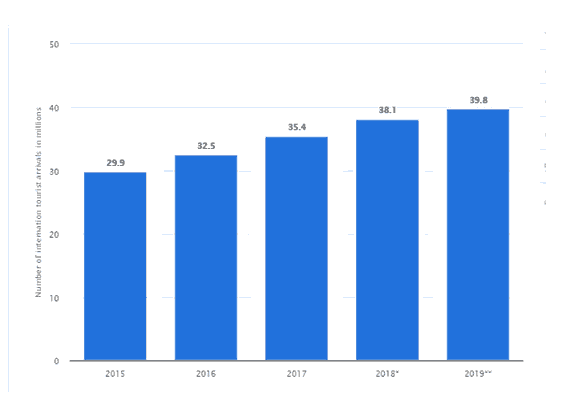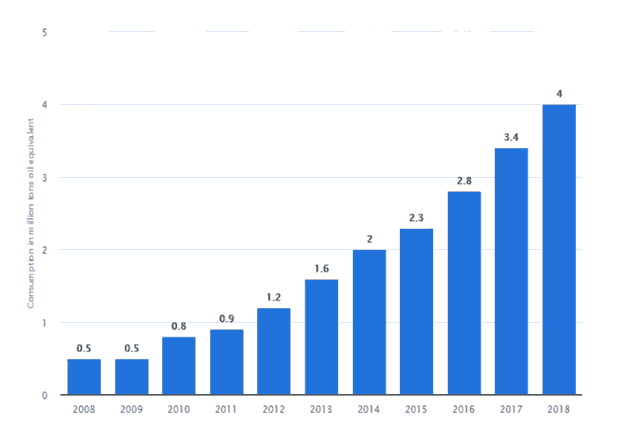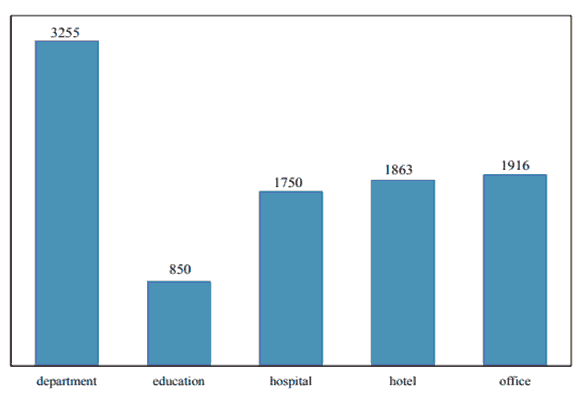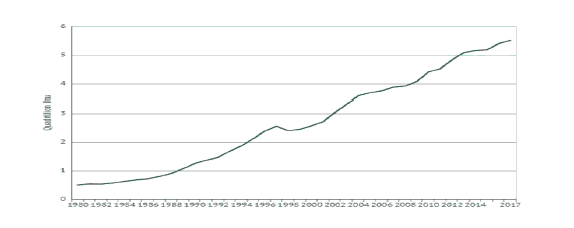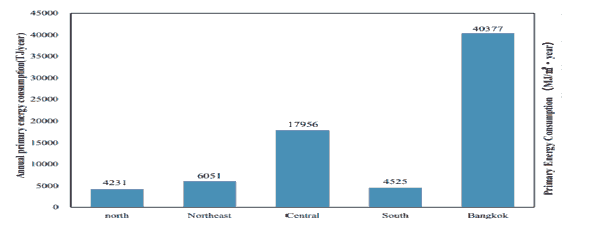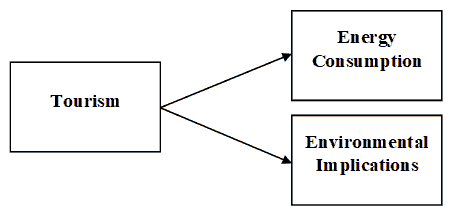Research Article: 2021 Vol: 24 Issue: 1S
Examination of the Influence of Tourism on Energy Consumption and the Environment- A Case of Thailand
Thitinant Wareewanich, Rajamangala University of Technology Tawan-OK
Thitinan Chankoson, Srinakharinwirot University
Abstract
Purpose: The purpose of the current research was to determine the influence of tourism on energy consumption and the environment in the context of Thailand.
Research Design: The findings of the study are based on the ARDL developed that was developed to execute the regression for the time series involving unit-roots (non-stationary). A total of 30 observations have been collected for the current research from the year’s 1989 to 2018 specific to the context of Thailand.
Findings and Limitations: The findings of the study reveal that there is a significant but negative impact of tourism on environment in the long run. However, no significant impact of tourism on energy consumption has been obtained. The findings of the research are specific Thailand and therefore, can be confidently applied to other geographical locations or countries with full confidence.
Keywords:
Tourism, Environment, Energy Consumption, Thailand
Intoduction
This is indubitable that in the contemporary time tourism is harmful to the environment and the sustainability criteria to maintain tourist destination is needed to be complied (Jermsittiparsert & Chankoson, 2019; Jermsittiparsert, Joemsittiprasert & Phonwattana, 2019). When it comes to general environmental impacts of tourism, there is broad understanding pertaining to it. The role of energy consumption pattern is crucial in enticing the attention of the people to visit a particular destination for the purpose of tourism (Nijkamp & Vreeker, 2000; Krutwaysho & Bramwell, 2010; Azam, Alam & Hafeez, 2018). In the conceptual framework of the tourism satellite accounts, tourism activities and attraction can be considered as sub-sector. Not only for the sake of the destination travelled by the tourists, but features of destination and its attraction also play a crucial role in this regard, and the tourism would not exist without such attraction. It has been inferred in various studies that the techniques of energy saving and the tools of sustainable management have an imperative role to play in the tourist attraction (Krutwaysho & Bramwell, 2010). There is a study in Germany that has investigated the environmental impacts of tourism and its role in tourism attraction.
In the countries, such as Thailand, where the rate of tourism is very high and the tourism industry is bolstering day by day, it is imperative that the contribution to the national bill ought to be determined. As per the Statista (2020) the rate of international tourist arrival keeps on increasing in Thailand. In the year of 2015, the number was 29.9 million, in the year of 2017; the number of international tourist arrival virtually accounted for 35.4 million, while in the year of 2019 there were 39.8 million international tourists. as shows in Figure 1.
Figure 1: Arrival of International Tourist in Thailand From the Year of 2015 to 2019
Source: (Statista, 2020)
Resultantly, the consumption of energy pattern in the region has drastically been changes, which imperiled the environmental sustainability of the region in jeopardy through which the tourism attraction in the region is eventually being affected. Along with the aforementioned fact, the consumption of energy in increasing day by day in Thailand, as per the Statista (2020) there is virtually 133 million tons of oil equivalent of primary energy were consumed in Thailand in from the year of 2008 to 2018.
Given that the consumption of energy in this amount could have drastic implications for the environment, which could cause to hamper tourist attraction in the region (Dogan, Seker & Bulbul, 2017; Usman, Alola & Sarkodie, 2020). The use of non-renewable energy resources as result of tourism activities causes environmental degradation, which affects the natural beauty of the tourist destinations, and as a result, tourist attraction is hindered (Le, Chang & Park, 2020). The reason is that, the use of non-renewable resources cause to release greenhouse gases or in other words, the gases, such as methane, carbon dioxide and other gasses into the atmosphere. Thus, in this manner, warming effect is created. Furthermore, the use of fossil fuels, such as coal, oil and natural gases contaminate the environment by polluting the water and air, public health and habitat loss, which cause tourists to stave them off visiting destinations in the region.
On the contrary, the use of renewable energy sources is harmonious with the environment and plays a positive role in the tourism attraction (Lebel et al., 2020). These sources can be utilized over and over without posing any threat to the sustainability of the environment and these sources are considered the most suitable form to clean environment. As per the report of International Renewable Energy Agency (IRENA), the use of solar water heating, sea water air conditioning, solar air conditioning and solar photovoltaic can further enhance the tourists’ attraction in the region. When it comes to Thailand, as per the Statista (2020) the use of renewable resources is increasing in the region. as shows in Figure 2.
There are various studies have been conducted that have focused on the impact of tourism and its activities on the energy consumption pattern and environment degradation, but there is not sufficient amount of studies that have systematically analysed the energy consumption pattern by the tourists in Thailand with a view of environmental implications. Therefore, by considering this, the main objectives of the study are:
• To assess the impact of tourism on environmental degradation Thailand.
• To assess the impact of tourism on energy consumption in Thailand.
• To give implications for planning and the industry.
The research question of the study has been designed as,
Q. What is the influence of Tourism on energy consumption and environment in the case of Thailand?
Literature Review
There is no doubt that during the past few decades, the relationship between the tourism with energy consumption and environment has been studied in various studies. It has been observed that the number of tourists have greatly been increased in globally, and when it comes to Thailand it is considered one of the most important destination for the tourists. There is substantial amount of international tourist visit this country every year (Naradda et al., 2017). The tourism generates great amount of national income of the country, but on the other hand, the activities tourism industry and tourist have caused to increase drastic increase in the energy consumption pattern in the reason, which leads to environmental degradation (Kelly & Williams, 2007). As the awareness regarding the impacts of tourism’s energy and activity on global environment has been increased; therefore, the knowledge as to the effects of energy consumption on the sustainability of the tourist destinations has also been increased.
There is vast amount of energy for the production of the products, services and visitors experience required by the tourism industry. To facilitate the accommodation and transportation of the travelers, energy is required. There are many forms for energy consumptions that are associated with the greenhouse gases that are benign with the sustainability of the environment, and cause to contaminate the environment (Michailidou et al., 2016). The environmental health, quality of air and water and experience of the visitors at a particular tourist’s destination can significantly be affected the various form of energy consumption (Dogan, Seker & Bulbul, 2017). In addition to this, the subsequent travel demand and opportunities of development for tourism industry can greatly be affected by the emission of greenhouse gases if they are not addressed in a proactive manner.
Through the help of a series of extraction, conversion and distribution systems, the energy is supplied to the tourist resorts. There is local system used to derive some energy, such as local wind, photovoltaic cells and micro-hydro. In certain regions these sources are more viable and others. When it comes to the energy use, what is typically associated with other similar sized communities, in tourism destination, energy use is normally disproportionately greater (Zhang & Gao, 2016). The use of energy extensive technologies through which the tourist amenities are delivered have considerable role to play in this regard. Furthermore, in importing food and other material goods, transporting water and disposing waste, there is a great reliance of considerable amount of energy in tourism industry.
The operation of accommodation facilities is another major component of energy use at tourism destination. The energy is used in all the areas such as hotels, bed and breakfast establishment, motels, and campground and backpacker facilities (Sharif et al., 2019). From the aforementioned forms of accommodations, the maximum amount of energy is generally consumed by the hotels as there are more energy-intensive facilities and services, such as bars, restaurants, swimming pools and in-house laundries are likely to have by them (Kelly & Williams, 2007). Besides, seasonal and permanent residents, and as well as tourists accompanied with their friends and families live in private homes, which has great contribution in the energy consumptions. as shows in Figure 3.
As per the Thailand Energy Report (2015), the jet fuel consumption increased in the region due to the increase in the foreign tourists. Besides, there is increased in 5 million people in foreign tourists from 2014 to 2015. In addition to this, due to the expansion in tourism industry, the power consumption increased 3.7 percent. It has been inferred in the report of World Data Atlas (2020) that the primary energy consumption in Thailand keeps on increasing since 1980. In the year of 2017, there was 5.52 quadrillion Btu. Primary energy consumption in Thailand. From the year of 1998 to the year of 2017, the primary energy consumption of Thailand increased from 2.39 quadrillion Btu in 1998 to 5.52 quadrillion Btu, which shows that at an average annual rate of 4.54%, the primary energy consumption is increasing in the region. as shows in Figure 4.
Furthermore, the central region of Thailand that is Bangkok and its annual consumption of primary energy accounts for 69% of total energy consumption of central region (Li, Kritsanawonghong & Gao, 2010). as shows in Figure 5.
There is significant energy demand in destinations is generated by the tourists’ attraction and activities. Certain mechanized tourist activities are specifically energy intensive. The heli-skiing, jet boat rides, scenic boat cruises, charter fishing operation and scenic flights are all included such activities (Dogan, Seker & Bulbul, 2017). Besides, in the up-and-down-stream business functions, for instance, marketing and goods transportation and tour office administration, energy is also used. It has been observed that in getting to and from the destination, as much as 90 percent of the estimated energy consumption by tourist is spent. When it comes to the major share of tourism-related use of energy, air travel in particular accounts for this (Nepal, Irsyad & Nepal, 2019). This is especially in the case of island destinations, where the vast majority of tourists arrive by airplane and more specifically in the case of developing countries, like Thailand.
By transforming fossil fuels, such as coal, oil, natural gas into various forms of energy, the destination energy requirements are largely met. The transformation process of these fossil fuels is no less than a grave threat for the environment and could imperil it in a serious predicament. There are different kinds of perilous chemical compounds that pervade in the environment in the form of sulphur oxide, nitrogen oxide, carbon monoxide and carbon dioxide and particulate matter are produced by these processes (Isik, Dogru & Turk, 2018). Furthermore, the volatile organic compounds that are referred to as additional chemicals can enter into the atmosphere, if the fuels used in this processes are not completely burned (Zaman et al., 2016). Therefore, in this manner, where these emissions are produced and released, significant environmental effects can be seen.
There could be a significant potential cumulative effects of energy-related emissions connected with tourism destination can be seen. Besides, motorized vehicles especially in heavily congested destinations release unburned hydrocarbons and nitrogen oxides that cause air pollution and ozone related smog (Azam, Alam & Hafeez, 2018). The physical appeal of destination is greatly reduced smog as it damages vegetation species and lessens the quality of scenic and visual resources. Furthermore, many outdoor activities are also participated by smog, and these activities are highly unpleasant to the tourists and could cause health issues, such as difficulties in breathing, dizziness and headaches.
The cumulative impact of the travel on global warming is greatly contributed by the destinations and activities of the tourism that generate carbon dioxide (Lenzen et al., 2018). The great amounts of aviation fuel consumed in bringing travelers to and from destination of the tourism, and all this attribute to the aircraft emissions. Like the carbon dioxide contributes to the climate change from the ground source, aircraft emissions also contribute in this manner (Kelly & Williams, 2007). The effects of the environment of the tourism extend well beyond the destinations, where into much broader geographical environment they are consumed and spilled over. Therefore, consistent with the view of the above information based on the past studies, these hypotheses are formulated:
H1: There is a significant impact of tourism activities on energy consumption in Thailand.
H2: There is a significant impact of tourism activities on environmental degradation in Thailand.
Theoretical Framework
Based on the activities of tourism and its relation with the pattern of energy consumption and environment, there are some theories that will be pertinent to it. The Value-Belief-Norm Theory will be absolutely compatible to apply in this context. By aping this theory pro-environmental behavior of the tourists that propel them the consume energy in an environmental friendly way. Therefore, the Value-Belief-Norm Theory is presented below:
The Value-Belief-Norm Theory
To expound the influence of human values on behavior in an environmentalist context, the value belief norm theory is presented by Stern as cited in Beckerman & Hepburn (2007). The relationship between the values, norms and beliefs and behavior in a casual chain is posited by the theory. A guiding principle for any behavior based on trans-situational goals that are desirable and, by relative importance vary, is referred to as value. There are various important values components come under the value (Ghazali et al., 2019). The values components are altruistic values, biosphere values, egoistic values, and openness to change values.
When it comes to altruistic values, they are the collective values that are related to other living species and people that encourage and propel them to engage in PEB. As far as the second type is concerned, which biospheric values, there is emphasis on the environment, the biosphere and the eco-system. The third type is known as egoistic, the self-interest in relation to the society is referred by it, and being influential, authority and wealth are included in it. The fourth type is considered as openness to change (Kiatkawsin & Han, 2017). This refers to own volition and motivation to take action to protect environment, and there are completely self-directed thoughts and actions. There are completely self-directed thoughts and actions which are based on the motivation for the independent actions of an individual that make the person act according to the culture (Han, 2015; Kiatkawsin & Han, 2017). In this context, such values mainly delineate the possibilities of segmentation between different ethnics groups based on the geographical boundaries.
The author Sánchez, et al., (2018) has utilized this theory for examining the personal values which are determined through the willingness to pay by the individuals for noise pollution. However, the author has undertaken three values as –egoistic, altruistic and biospheric, but did not focused on other values such as norms and beliefs. As per the extended value belief norm theory, a number of researchers have predicted that PEB is most important antecedent of social norm (Jansson, Marell & Nordlund, 2011; López-Mosquera & Sánchez, 2012). Considering this finding, the model has been extended with the addition of social norms for the purpose of examining its significant influences on the PEB. In addition to the aforementioned statement, the social norms mainly reflect the pressures of the society which an individual experience from others in order to engage in a specific behavior.
It has been critically appraised by Van Ripe & Kyle (2014) that the people which are influenced by the social norms are more likely to assent to the advices and opinions given by opinion leaders or other individuals including family, peers and colleagues. This is the reason that the behaviour, norms, values and traditions shapes the persons attitude towards social and environmental sustainability and has narrowed down their focus towards green behaviors (Lind et al., 2015; Fornara et al., 2016). Moreover, the individuals are likely involved in the actions which can protect the environment from the destructive influences of human activities which destroys the nature. In this essence, the VBN theory complements the green behavior of the individuals and majorly influences their values, norms and beliefs.
Conceptual Framework
The following is the conceptual model for the current research. The study encompasses independent as tourism whereas, the energy consumption and environmental implications are the dependent variables of the study (Figure 6).
Research Method
Research Data Collection
The current study has adopted the quantitative research approach in which quantifiable evidences have been collected from the available secondary sources. The researcher has intended to collect the data for three variables that were energy consumption, environmental implications and tourism. As discussed, the primary focus of the study is to assess how tourism influences energy consumption and the environment in Thailand. Therefore, the researcher has gathered time series of 30 years from 1989 to 2018 from World Bank Data. Since the researcher has collected data of 30 years therefore, the total number of observations for the current study is 30 observations. Specifically, the time series for CO2 emission has been gathered in kilo tonnes. The total number of international visitors/tourists has been referred for tourism while. The time series for energy consumption has been measured in kg of oil equivalent per capita.
Data Analysis Method
The selection of appropriate methods and techniques for the analysis is considered important because of the reason that concreteness and appropriateness of findings are subject to the data analysis techniques that are applied utilized. In the current research, the researcher has gathered time series for the three concerned variables. Therefore, it becomes mandatory to treat the data from the assumptions that are considered important in statistics. With reference to the findings of Górecki (2018), the statistical assumptions in the form of normality, stationary and multi-collinearity are vitally important while comprehending the nature of time series.
As per the findings of Moder (2013), the normality of data is mainly tested through Jarque-Bera testing. The technique is being used to determine whether the data is approximately normally distributed. Through the Jarque-Bera testing, it has been identified that time series of CO2 emission and energy consumption is normal however, the time series of tourists/ tourism was not normal. Furthermore, the stationary of time series has also been tested. The study of KosicKA (2015) suggests that in order to examine whether the data is stationary or non-stationary, it is determined that whether time series entails unit-roots. Furthermore, the study of Harvey (2013), inferred that the determination of unit roots is mainly supported by the Augmented-Dickey Fuller technique (ADF). With reference to the findings of Nkoro (2016), ADF is an essential technique that forms on the basis of the supposition that time series entails unit-roots (null hypothesis). The acceptance and not acceptance of the null-hypothesis determine the time possesses or does not possess unit-roots respectively. In realization to this, the researcher utilized Autoregressive Distributive Lag as the technique that can be adequately analyses time series involving unit-roots i.e., non-stationary data. Since, the study involves two dependent and one independent variables, therefore in order to establish the causal relationship between the variables, two ARDL models have been developed whose equations are presented below:
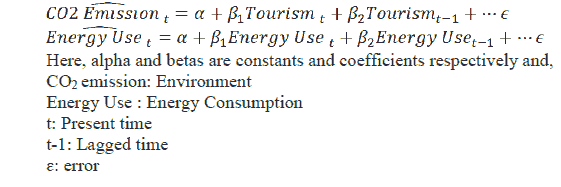
Analysis and Results
Descriptive Statistics
The following descriptive statistics have been presented in order to comprehend the nature of the time series. In the table (Table 1), the mean value for CO2 emission has been highlighted as 222503. However, the deviation of 80405% has also been computed by its values from its mean. Moreover, the high deviation is also evident from its maximum and minimum where a considerable difference between the values can be observed. The mean for energy use has been computed as 1415. The standard deviation of 451% has also been computed for energy use. Moreover, the high deviation is also evident by considering the minimum and maximum values within this time series. In the case of number of arrivals (tourism), the mean value has been computed as 14932700. Further, the deviation of 9383857 has also been computed. In this aspect, the higher deviation can be claimed as the significant difference between the minimum and maximum values also indicates the high standard deviation with the time series of tourism.
The table below also demonstrates the Jarque-Bera values along with its probability for all the concerned time series. With reference to the study of Kim (2016), Jarque-Bera testing is considered to be an essential statistical technique that helps in determining the normality of the obtained data. Jarque Bera values for CO2 emission have been computed as 1.333 [0.513]. Since the probability has appeared greater than the threshold of 0.05. In this aspect, it can be stated the data has not distributed approximately thereby suggesting the data is normal. Moreover, Jarque-Bera values for energy use have been computed as 1.775 [p=0.412]. Since p-value has been computed as greater than 0.05 therefore, it can be suggested that data has not approximately distributed and the data is normal. Lastly, the values for number of tourists/arrivals have been obtained as 7.262 [0.026]. In this sense, it can be articulated that the data within this time series is not normal.
| Table 1 Descriptive Statistics |
|||
|---|---|---|---|
| CO2_Emissions | Energy_Use | Number_Of_Arrivals | |
| Mean | 222503 | 1415 | 14932700 |
| Median | 233881 | 1431 | 11220000 |
| Maximum | 358873 | 2145 | 38350667 |
| Minimum | 78892 | 657 | 6952000 |
| Std. Dev. | 80405 | 451 | 9383857 |
| Jarque-Bera | 1.333 | 1.775 | 7.262 |
| Probability | 0.513 | 0.412 | 0.026 |
| Observations | 30 | 30 | 30 |
Augmented Dickey Fuller Testing
Augmented Dickey-Fuller testing is considered to be one commonly utilised diagnostic tool that helps in determining whether a time series is stationary or non-stationary. As already discussed, the ADF technique forms the basis with the testing of unit roots and suggests that time-series entails unit roots. The table below (Table 2) is the unit root testing for the time series environmental implications (CO2 emission). The t-statistics have been obtained as -1.4094 [p=0.5599]. Since the p-value has appeared greater than the threshold of 0.05. Therefore, the null hypothesis can be rejected which suggests the environmental implications entail unit roots. Therefore, it can be stated that the time series is non-stationary.
| Table 2 Unit Root Testing for Environmental Implications |
||
|---|---|---|
| t-Statistic | Prob.* | |
| Augmented Dickey-Fuller test statistic | -1.4094 | 0.5599 |
The following table (Table 3) highlights unit root testing for a time series CO2 emission. The t-statistic for this time series has been computed as -1.6433 [p=0.449]. As the p-value has appeared as greater than the threshold level hence, the null hypothesis can be rejected. This suggests the time series CO2 emission exhibits unit roots. This suggests that time series is non-stationary.
| Table 3 Unit Root Testing for CO2 Emission |
||
|---|---|---|
| t-Statistic | Prob.* | |
| Augmented Dickey-Fuller test statistic | -1.6443 | 0.4449 |
The following is the unit-root testing for the time series tourism. The t-statistic has been obtained as 2.0603 [p=0.998]. It is notable that the obtained p-value has appeared as greater than the threshold of 0.05. In this sense, the null hypothesis can also not be rejected and suggests the time series entails unit roots. Moreover, it can also be stated that the time series is non-stationary. as shows in Table 4.
| Table 4 Unit Root Testing For Tourism |
||
|---|---|---|
| t-Statistic | Prob.* | |
| Augmented Dickey-Fuller test statistic | 2.0603 | 0.9998 |
Autoregressive Distributed Lag
In the preceding sections, the researcher has tested the time series against different statistical assumptions. The assumptions that were normality and stationarity. Through the testing, it has been determined that the obtained series is normal and entails unit roots. With reference to the findings of Faes (2012), once the statistical assumptions such as stationary of data are not fulfilled, the execution of regression to determine the causal relationship becomes more complex. In this regard, the technique Auto-Regressive Distributed Lag (ARDL) is the most commonly applied technique which is preferably utilized to examine the causal relationship in the time series exhibiting unit roots. The study of Mugableh (2013), has also defined the usefulness of the ARDL technique and suggested that the technique is essential in utilizing the historical and in maximizing the marginal log observations that help in predicting future values. Since the researcher has also intended to utilize time series reflecting the historical data and aims to determine the causality between the variables, therefore, it can be stated that the use of ARDL in the context of the current research is justified. As the current study involves the assessment of tourism on energy consumption and CO2 emission, therefore, two ARDL models have been developed in order to analyses the regression on two dependent variables of the study. Here it becomes important to mention that the selection of the lag has been done automatically by the software used for the analysis.
The table below (Table 5) is the developed ARDL in relation between tourism and the environment. Based on the below model, it can be stated that CO2 emission is dependent on the first lag. It has been because of the obtained t-statistics 21.379 [p=0.000] and is significant at 1 % threshold. It has been because of the obtained p-value which has appeared as p=0.000 (<0.05).
| Table 5 Ardl in Relation Between Tourism and Environment |
||||
|---|---|---|---|---|
| Variable | Coefficient | Std. Error | t-Statistic | Prob.* |
| CO2_Emission (-1) | 0.871*** | 0.041 | 21.379 | 0.000 |
| Tourists | -0.111*** | 0.080 | -1.390 | 0.177 |
| Tourists(-1) | 0.166 | 0.096 | 1.735 | 0.095 |
| C | 0.315 | 0.093 | 3.371 | 0.002 |
| R-squared | 99% | F-statistic | 723.404 | |
| Adjusted R-squared | 99% | Prob(F-statistic) | 0.000 | |
In terms of the dependent variable, it can also be stated that tourist is significant at its level. It has been due to the obtained t-statistics -1.390 [0.177]. However, the t-statistics by considering the lag technique suggest that tourists are not dependent on its first lag. It has been because of the t-statistics that have been computed as 1.735 [p=0.095]. Furthermore, the R-square value has been computed as 99%. This suggests that tourists predict 99 % of the developed regression model. Moreover, the F-statistic of 723.404 [p=0.000] suggests that tourism influences the environment significantly when it is at its level. Nonetheless, the impact was negative. Therefore, it can be stated that tourism establishes negative long-term association with environment.
The following (Table 6) is the insights pertaining to the developed ARDL model in the relation between tourism and energy use. The table below suggests that energy use is dependent on its first lag. It has been because of the t-statistic that has been obtained as 16.400 [p=0.000] significance at a 1 % threshold. However, it has also been computed that tourism is not significant at its level. In this manner, it can be inferred that there is no long term association between tourism and energy use. Here it becomes important to mention that the developed model was predicted to 99% from the independent variable yet, no significant impact of tourism on energy use has been computed. as shows in Table 7.
| Table 6 ARDL in the Relation Between Tourism and Energy Consumption |
||||
|---|---|---|---|---|
| Variable | Coefficient | Std. Error | t-Statistic | Prob.* |
| Energyuse(-1) | 0.859*** | 0.052 | 16.400 | 0.000 |
| Tourista | 0.130 | 0.073 | 1.782 | 0.087 |
| C | 0.133 | 0.231 | 0.575 | 0.570 |
| R-squared | 99% | F-statistic | 1003.450 | |
| Adjusted R-squared | 99% | Prob(F-statistic) | 0.000 | |
Table 7 Summary of Hypothesis |
||
|---|---|---|
| S. No | Hypothesis | Status |
| H1 | There is a significant impact of tourism in Thailand on its energy consumption | Rejected |
| H2 | There is a significant impact of tourism in Thailand on its environment. | Accepted (Long term) |
Conclusion
The current study has adopted the quantitative approach in order to determine the influence of tourism on energy consumption and the environment. The study’s findings are based on the time series collected for 30 years thereby making the total number of observations as 30. The researcher intended to test the time series in order to validate the data from the statistical assumptions in the form of normality and stationarity. Through the diagnostic and descriptive, the normality and stationarity of time series were determining. The Jarque-Bera testing revealed that time series in the form of CO2 emission and energy use was normal however, the time series for tourism was not normal. Furthermore, the unit-root testing was also executed in order to determine the stationarity of the time series. Since all the time series exhibited unit roots therefore, it can be stated that all three time series were non-stationary.
Since the researcher found unit roots in all the three time series, therefore, an ARDL model was developed in order to execute regression in the relation between the tourism (independent) and two dependent variables that were energy consumption and environment. The findings of the research reveal that tourism significantly but negatively influence the environment in the long term. This concludes that excessive and increasing tourism activities can yield an adverse effect to the environment of Thailand because tourism activities in longer terms can yield high emission of CO. On the other, the findings also reveal that tourism does not influence the energy consumption in the context of Thailand. This suggests that in the context of Thailand, tourism is not dependent on excessive energy usage. Therefore, tourism activities do not influence energy use and consumption in the country.
Recommendations
Based on the findings of the current research, the following recommendations are essential to provide:
• In the current, it has been determined that tourism yields a negative impact on the environment in the long term. This infers that the visitors visiting to witness Thailand tourism are not focusing to preserve its environment. It has been determined and forecasted that excessive tourism would bring more environmental damages to the country. Therefore, it is recommended to the tourism sector of Thailand to bring more appropriate measures and reforms that can help the sector in preserving its environment.
• It is recommended to Tourism Authority of Thailand to make awareness to local and international tourists regarding the increasing environmental damages and the harmful effect of CO2 emission on the worth-seeing natural beauty of Thailand.
• The study reveals that there is a significant impact of tourism on energy consumption. This suggests that tourism activities do not form a linkage with energy consumption. Nonetheless, it can also be predicted that with the increased use of automobiles and man-made artifacts, energy consumption for tourism can be enhanced. In this manner, it is suggested to tourism businesses and concerned stakeholders to pursue the sustainable use of energy sources so that tourism activities cannot influence the energy consumption in the country.
Limitations of the Research
In the current study, the primary focus of the researcher was to investigate the concerned research phenomenon from the perspective of Thailand. However, in terms of applying the current research findings to different geographical locations, the study has considerable limitations. Furthermore, quantifiable evidence has been gathered for the current research. The study lacks significantly in providing qualitative evidence. Therefore, it can be stated that the study has limitations while providing more insightful knowledge pertaining to the research phenomenon.
Acknowledgement
Thitinan Chankoson is the corresponding author.
References
- Azam, M., Alam, M.M., & Hafeez, M.H. (2018). Effect of tourism on environmental pollution: Further evidence from Malaysia, Singapore and Thailand. Journal of cleaner production, 190, 330-338.
- Azam, M., Alam, M.M., & Hafeez, M.H. (2018). Effect of tourism on environmental pollution: Further evidence from Malaysia, Singapore and Thailand. Journal of cleaner production, 190, 330-338.
- Beckerman, W., & Hepburn, C. (2007). Ethics of the discount rate in the stern review on the economics of climate change. World Economics-Henley on Thames, 8(1), 187.
- Dodds, R., Graci, S.R., & Holmes, M. (2010). Does the tourist care? A comparison of tourists in Koh Phi Phi, Thailand and Gili Trawangan, Indonesia. Journal of Sustainable Tourism, 18(2), 207-222.
- Dogan, E., Seker, F., & Bulbul, S. (2017). Investigating the impacts of energy consumption, real GDP, tourism and trade on CO2 emissions by accounting for cross-sectional dependence: A panel study of OECD countries. Current Issues in Tourism, 20(16), 1701-1719.
- Faes, L., Erla, S., & Nollo, G. (2012). Measuring connectivity in linear multivariate processes: Definitions, interpretation, and practical analysis. Computational and mathematical methods in medicine, 2012.
- Fornara, F., Pattitoni, P., Mura, M., & Strazzera, E. (2016). Predicting intention to improve household energy efficiency: The role of value-belief-norm theory, normative and informational influence, and specific attitude. Journal of Environmental Psychology, 45, 1-10.
- Ghazali, E.M., Nguyen, B., Mutum, D.S., & Yap, S.F. (2019). Pro-environmental behaviors and value-belief-norm theory: Assessing unobserved heterogeneity of two ethnic groups. Sustainability, 11(12), 3237.
- Górecki, T., Hörmann, S., Horváth, L., & Kokoszka, P. (2018). Testing normality of functional time series. Journal of time series analysis, 39(4), 471-487.
- Han, H. (2015). Travelers' pro-environmental behavior in a green lodging context: Converging value-belief-norm theory and the theory of planned behavior. Tourism Management, 47, 164-177.
- Harvey, D.I., Leybourne, S.J., & Taylor, A.R. (2013). Testing for unit roots in the possible presence of multiple trend breaks using minimum Dickey–Fuller statistics. Journal of Econometrics, 177(2), 265-284.
- Heidari, H., Katircioğlu, S.T., & Saeidpour, L. (2015). Economic growth, CO2 emissions, and energy consumption in the five ASEAN countries. International Journal of Electrical Power & Energy Systems, 64, 785-791.
- Isik, C., Dogru, T., & Turk, E.S. (2018). A nexus of linear and non‐linear relationships between tourism demand, renewable energy consumption, and economic growth: Theory and evidence. International Journal of Tourism Research, 20(1), 38-49.
- Jansson, J., Marell, A., & Nordlund, A. (2011). Exploring consumer adoption of a high involvement eco‐innovation using value‐belief‐norm theory. Journal of Consumer Behaviour, 10(1), 51-60.
- Jermsittiparsert, K., & Chankoson, T. (2019). Behavior of tourism industry under the situation of environmental threats and carbon emission: Time series analysis from Thailand. International Journal of Energy Economics and Policy, 9(6), 366-372.
- Jermsittiparsert, K., Joemsittiprasert, W., & Phonwattana, S. (2019). Mediating role of sustainability capability in determining sustainable supply chain management in tourism industry of Thailand. International Journal of Supply Chain Management, 8(3), 47-58.
- Kelly, J., & Williams, P.W. (2007). Modelling tourism destination energy consumption and greenhouse gas emissions: Whistler, British Columbia, and Canada. Journal of Sustainable Tourism, 15(1), 67-90.
- Kiatkawsin, K., & Han, H. (2017). Young travelers' intention to behave pro-environmentally: Merging the value-belief-norm theory and the expectancy theory. Tourism Management, 59, 76-88.
- Kiatkawsin, K., & Han, H. (2017). Young travelers' intention to behave pro-environmentally: Merging the value-belief-norm theory and the expectancy theory. Tourism Management, 59, 76-88.
- Kim, N. (2016). A robustified Jarque–Bera test for multivariate normality. Economics Letters, 140, 48-52.
- Knoema. (2020) Thailand - Total primary energy consumption.
- KosicKA, E., KozłowsKi, E., & MAzurKiEwicz, D. (2015). The use of stationary tests for analysis of monitored residual processes. Eksploatacja i Niezawodność, 17.
- Krutwaysho, O., & Bramwell, B. (2010). Tourism policy implementation and society. Annals of Tourism Research, 37(3), 670-691.
- Le, T.H., Chang, Y., & Park, D. (2020). Renewable and nonrenewable energy consumption, economic growth, and emissions: International evidence. The Energy Journal, 41(2).
- Lebel, L., Haefner, A., Pahl-Wostl, C., & Baduri, A. (2020). Governance of the water-energy-food nexus: Insights from four infrastructure projects in the Lower Mekong Basin. Sustainability Science, 1-16.
- Lenzen, M., Sun, Y.Y., Faturay, F., Ting, Y.P., Geschke, A., & Malik, A. (2018). The carbon footprint of global tourism. Nature Climate Change, 8(6), 522-528.
- Li, Z., Kritsanawonghong, S., & Gao, W. (2010). Energy use and consumption of thailand’s commercial buildings In education, 121(91), 75.
- Lind, H.B., Nordfjærn, T., Jørgensen, S.H., & Rundmo, T. (2015). The value-belief-norm theory, personal norms and sustainable travel mode choice in urban areas. Journal of Environmental Psychology, 44, 119-125.
- López-Mosquera, N., & Sánchez, M. (2012). Theory of planned behavior and the value-belief-norm theory explaining willingness to pay for a suburban park. Journal of environmental management, 113, 251-262.
- Michailidou, A.V., Vlachokostas, C., Moussiopoulos, Ν., & Maleka, D. (2016). Life cycle thinking used for assessing the environmental impacts of tourism activity for a Greek tourism destination. Journal of Cleaner Production, 111, 499-510
- Moder, K., Střelec, L., & Stehlík, M. (2013, October). Selected issues on robust testing for normality. In AIP Conference Proceedings 1558(1), 24-727. American Institute of Physics.
- Mugableh, M.I. (2013). Analysing the CO2 emissions function in Malaysia: Autoregressive distributed lag approach. Procedia Economics and Finance, 5, 571-580.
- Naradda-Gamage, S.K., Hewa-Kuruppuge, R., & Haq, I.U. (2017). Energy consumption, tourism development, and environmental degradation in Sri Lanka. Energy Sources, Part B: Economics, Planning, and Policy, 12(10), 910-916.
- Nepal, R., al Irsyad, M.I., & Nepal, S.K. (2019). Tourist arrivals, energy consumption and pollutant emissions in a developing economy–implications for sustainable tourism. Tourism Management, 72, 145-154.
- Nijkamp, P., & Vreeker, R. (2000). Sustainability assessment of development scenarios: Methodology and application to Thailand. Ecological Economics, 33(1), 7-27.
- Nkoro, E., & Uko, A.K. (2016). Autoregressive Distributed Lag (ARDL) cointegration technique: Application and interpretation. Journal of Statistical and Econometric Methods, 5(4), 63-91.
- Sánchez, M., López-Mosquera, N., Lera-López, F., & Faulin, J. (2018). An extended planned behavior model to explain the willingness to pay to reduce noise pollution in road transportation. Journal of cleaner production, 177, 144-154.
- Sharif, A., Saha, S., Campbell, N., Sinha, A., & Ibrahiem, D.M. (2019). Tourism, environment and energy: An analysis for China. Current Issues in Tourism, 1-20.
- Statista. (2020). [Online] Available at: https://www.statista.com/statistics/613181/renewable-energy-consumption-in-thailand/ [Accessed 24 February 2020].
- Statista. (2020). Number of international tourist arrivals in Thailand from 2015 to 2019.
- Statista. (2020). Primary energy consumption in Thailand from 2008 to 2018.
- Thailand Energy Report. (2015)
- Usman, O., Alola, A.A., & Sarkodie, S.A. (2020). Assessment of the role of renewable energy consumption and trade policy on environmental degradation using innovation accounting: Evidence from the US. Renewable Energy.
- Van Riper, C.J., & Kyle, G.T. (2014). Understanding the internal processes of behavioral engagement in a national park: A latent variable path analysis of the value-belief-norm theory. Journal of Environmental Psychology, 38, 288-297.
- Zaman, K., Shahbaz, M., Loganathan, N., & Raza, S.A. (2016). Tourism development, energy consumption and environmental Kuznets Curve: Trivariate analysis in the panel of developed and developing countries. Tourism Management, 54, 275-283.
- Zhang, L., & Gao, J. (2016). Exploring the effects of international tourism on China's economic growth, energy consumption and environmental pollution: Evidence from a regional panel analysis. Renewable and Sustainable Energy Reviews, 53, 225-234.
